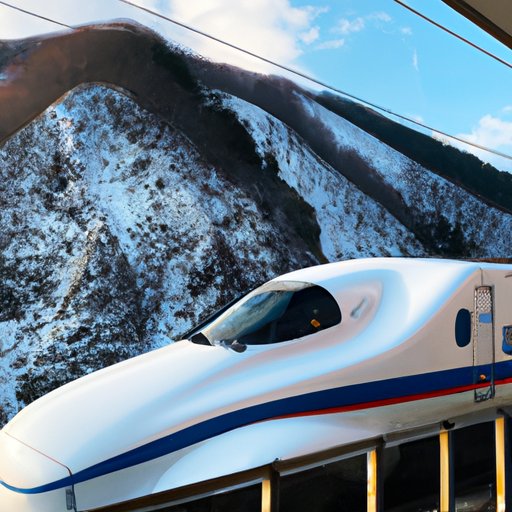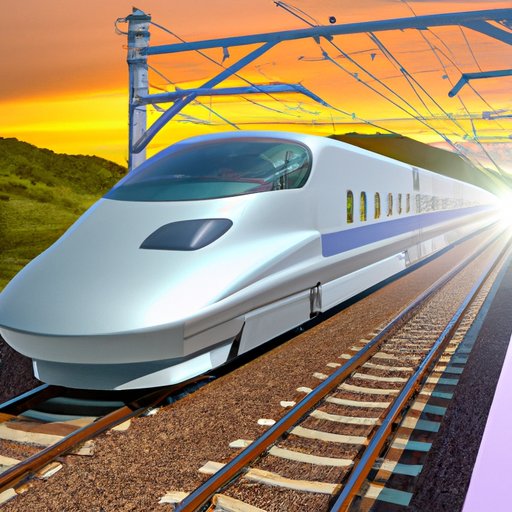Introduction
Bullet trains, or high-speed rail systems, are one of the fastest and most efficient forms of transportation around the world. These systems have been designed to reach speeds of up to 360 km/h (224 mph) in some cases, making them a popular choice for commuters who want to save time and money on their travels. In this article, we’ll take a closer look at how fast do bullet trains travel and explore the many advantages of high-speed rail.

Exploring the Fastest Operating Bullet Trains Around the World
The fastest operating bullet trains in the world can be found in countries such as China, Japan, France, Germany, Spain, Italy, and the United Kingdom. In China, the Shanghai Maglev Train holds the record for the fastest speed achieved by a commercial train, reaching 431 km/h (268 mph). Japan’s Shinkansen is another example of a fast-moving train, reaching 320 km/h (199 mph) in some cases. Other countries have achieved impressive speeds with their own high-speed rail systems, such as France’s TGV, Germany’s InterCity Express, Spain’s AVE, Italy’s Frecciarossa, and the UK’s Eurostar.
There are a few factors that determine the top speeds achieved by these trains, such as the length of the track, the type of engine used, and the number of stops along the route. Longer tracks allow for higher speeds, while shorter routes tend to be more limited. Additionally, different types of engines can affect the speed of the train, as some are designed to reach higher speeds than others. Finally, the number of stops a train makes on its journey can also slow it down, as the train must come to a complete stop before continuing.
Examining the Relationship Between Speed and Safety in Bullet Trains
When discussing the speed of bullet trains, it’s important to consider the relationship between speed and safety. High-speed rail systems have been designed with safety in mind, incorporating features such as advanced braking systems, automatic speed controls, and sophisticated signaling systems to ensure that trains remain on track and don’t exceed the maximum speed limit. Additionally, many countries have adopted a “safety first” approach to their high-speed rail networks, prioritizing safety over speed when it comes to designing and maintaining the system.
However, there is an ongoing debate about whether faster trains are necessarily safer. Some argue that higher speeds increase the risk of accidents, while others point out that the design features and safety protocols implemented by high-speed rail systems can actually reduce the risk of accidents. Ultimately, it’s up to each country to decide what level of speed and safety they are comfortable with when it comes to their high-speed rail networks.
The Future of High-Speed Rail: What Does It Mean for Commuters?
As technology continues to advance, the speeds achieved by bullet trains are expected to increase in the future. Some experts predict that speeds of up to 500 km/h (311 mph) could be achieved in the near future, allowing for even faster journeys and cost savings for commuters. This means that travelers will be able to get from one place to another in a fraction of the time it would normally take, making high-speed rail a more attractive option than other forms of transportation.
In addition to saving time, high-speed rail can also offer cost savings for commuters. With faster journey times, travelers can save money on tickets and avoid the costs associated with delays and cancellations. This makes high-speed rail an affordable and efficient way to get from one place to another.
How Do Bullet Trains Compare to Other Modes of Transportation?
When comparing bullet trains to other modes of transportation, it’s important to consider both efficiency and comfort. High-speed rail systems are known for their reliability and punctuality, meaning that commuters can rely on them to get to their destination on time. Additionally, bullet trains offer a more comfortable journey than planes or cars, with spacious seating and plenty of legroom. This allows travelers to relax during their journey and arrive at their destination feeling refreshed.
From an economic perspective, high-speed rail is often a more cost-effective option than flying or driving. With faster journey times and lower ticket prices, travelers can save money on their travels and still enjoy a comfortable journey. Additionally, governments can save money on infrastructure costs, as high-speed rail networks require less infrastructure than traditional rail networks.
Investigating the Economic Benefits of High-Speed Rail
The economic benefits of high-speed rail extend beyond just cost savings for travelers. Governments can also benefit from investing in high-speed rail networks, as they can generate significant savings on infrastructure costs. Additionally, high-speed rail projects can create jobs and boost local economies, as they require a large workforce to build and maintain the system.
High-speed rail can also offer economic benefits to businesses. For instance, companies can use high-speed rail to transport goods quickly and efficiently, reducing delivery times and costs. This can help businesses stay competitive in today’s global market and give them an edge over their competitors.

Exploring the Environmental Impact of Bullet Trains
High-speed rail systems are also beneficial for the environment. By reducing the need for cars and airplanes, bullet trains can help reduce air pollution and conserve energy. Additionally, some high-speed rail networks are powered by renewable sources of energy, such as solar and wind power, further reducing their environmental impact.
Overall, high-speed rail systems provide a number of benefits for both commuters and the environment. They offer a reliable and efficient form of transportation, with faster journey times and lower ticket prices. They also create jobs and help reduce air pollution, making them a worthwhile investment for governments and businesses alike.
Conclusion
Bullet trains, or high-speed rail systems, are one of the fastest and most efficient forms of transportation available today. They have been designed to reach speeds of up to 360 km/h (224 mph) in some cases, offering commuters a reliable and cost-effective way to get from one place to another. Additionally, high-speed rail systems have a number of environmental and economic benefits, such as reducing air pollution, creating jobs, and saving governments money on infrastructure costs.
As technology continues to improve, the speeds achieved by bullet trains are expected to increase in the future. This means that travelers will be able to get from one place to another in a fraction of the time it would normally take, making high-speed rail an even more attractive option than other forms of transportation. Ultimately, the future of bullet train technology looks promising, with the potential to revolutionize the way we travel and improve our lives.
(Note: Is this article not meeting your expectations? Do you have knowledge or insights to share? Unlock new opportunities and expand your reach by joining our authors team. Click Registration to join us and share your expertise with our readers.)
